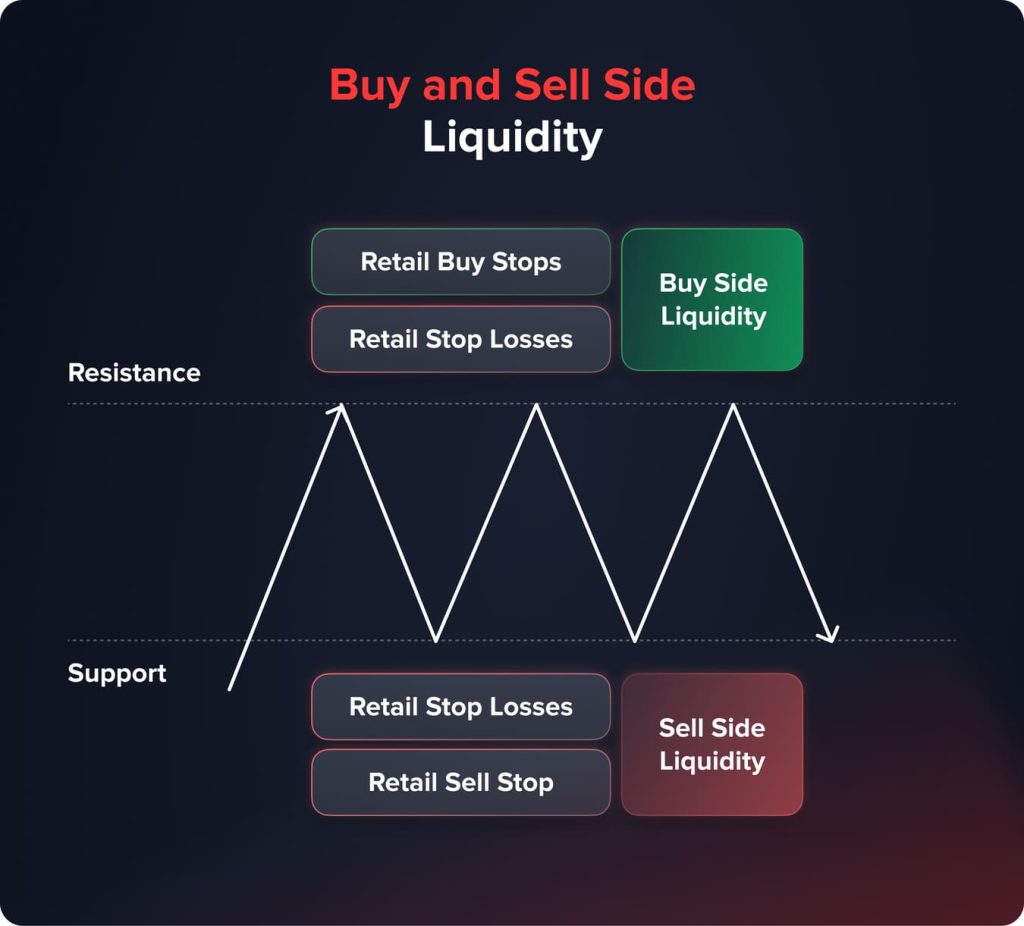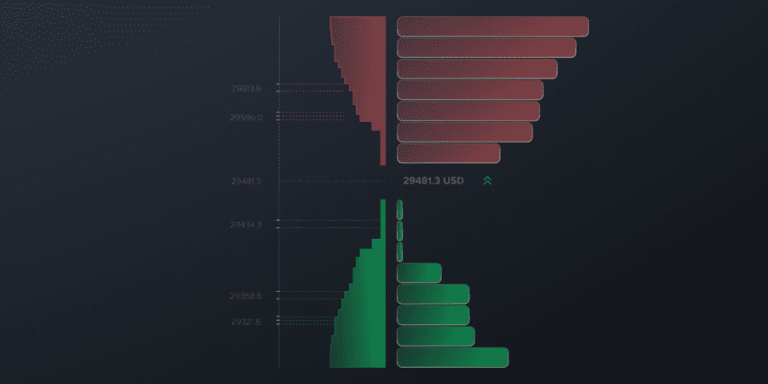
Thanh khoản mua và bán – Hoạt động như thế nào?
Mục lục
Khái niệm thanh khoản bên mua và bên bán đóng vai trò quan trọng trên thị trường tài chính. Thanh khoản đề cập đến mức độ dễ dàng mua hoặc bán tài sản, và việc xác định các khu vực có thanh khoản mạnh có thể cung cấp những hiểu biết giá trị về hành vi thị trường. Bài viết này sẽ định nghĩa bên mua và bên bán, giải thích khái niệm thanh khoản và tìm hiểu cách thức hoạt động của thanh khoản trong thực tế.
Bên mua bao gồm các nhà đầu tư tổ chức như quỹ đầu cơ, quỹ hưu trí và các công ty quản lý tài sản mua chứng khoán. Bên bán bao gồm các nhà môi giới, ngân hàng và các công ty khác tham gia vào việc phát hành và giao dịch tài sản. Cả hai bên tương tác để tạo điều kiện thuận lợi cho thị trường, với thanh khoản xuất hiện từ các hoạt động tổng hợp của họ. Bằng cách hiểu được nơi thanh khoản tích lũy, chúng ta có thể dự đoán các biến động giá tiềm năng và cải thiện giao dịch của mình.
Thanh khoản phía mua là gì?
Thanh khoản bên mua xuất hiện từ vị thế của các nhà giao dịch đã bán khống. Việc hiểu được vị trí mà những người bán khống này thường đặt lệnh dừng lỗ bảo vệ sẽ cung cấp cái nhìn sâu sắc có giá trị về các vùng thanh khoản tiềm năng của bên mua.
Vùng mua thường hình thành trên các mức kháng cự nổi bật. Kháng cự là nơi xu hướng tăng không thể tiếp tục leo cao hơn, được biểu thị bằng sự sụt giảm nhiệt tình mua vào và gia tăng các vị thế bán ngắn hạn diễn ra trên mức giá đó. Đối với các tài sản chủ động, thường có sự tập trung các vị thế bán ngắn hạn, tạo ra các vùng mua rõ ràng ngay trên các con số tròn tâm lý hoặc mức giá kỹ thuật nơi đã chứng kiến hoạt động bán trước đó.

Các nhà giao dịch sẽ theo dõi các mức kháng cự quan trọng có khả năng thu hút người bán khống ngắn hạn, chẳng hạn như các số nguyên, đường trung bình động, đường xu hướng từ đỉnh hoặc đáy, và các mức thoái lui Fibonacci hữu ích để xác định vùng kháng cự ngắn hạn có thể chuyển thành vùng mua tiềm năng. Những người bán khống cho rằng đà tăng đã hết có thể vào lệnh bán khống ở hoặc trên các mức kỹ thuật này.
Ví dụ, nếu một cổ phiếu gặp phải mức kháng cự là 50 đô la và do đó thu hút các vị thế bán khống, thì lý do khiến những người bán khống thoái lui là họ sẽ đặt mức dừng lỗ bảo vệ ở mức 1-2 đô la trên mức 51-52 đô la là mức giá thoát lệnh thấp nhất có thể chấp nhận được.
Bây giờ, nếu đợt bán tháo bắt đầu mất đà và một số người mua xuất hiện, trong giao dịch và có thể vượt qua vùng mua đã xác định là 51-52 đô la, các lệnh mua sẽ bắt đầu xếp hàng qua và trên 51-52 đô la khi lệnh dừng được kích hoạt, từ đó thúc đẩy nhiều lệnh bán khống, đẩy giá lên cao hơn nữa.
Trong các thị trường đang củng cố, nơi ngưỡng hỗ trợ và kháng cự được xác định lại, thanh khoản bên mua có thể bị kiểm tra nhiều lần. Khi các ngưỡng được kiểm tra lại, người bán khống có thể thận trọng nâng vị trí đặt lệnh dừng lỗ cao hơn khi giá hồi phục sau khi ngưỡng được xác nhận. Các vùng dừng lỗ tập trung phía trên ngưỡng kháng cự đang hình thành có thể đặc biệt tiết lộ vị thế bán khống nếu chúng bị phá vỡ theo cách kích hoạt đà tăng do lực bán khống đẩy giá lên cao hơn.
Thanh khoản bán là gì?
Vùng thanh khoản bán xuất hiện từ vị thế của các nhà giao dịch đã thiết lập vị thế mua đối với một tài sản. Các vùng này được hình thành bên dưới các mức giá hỗ trợ chính, nơi các nhà giao dịch ở phía mua của thị trường sẽ quan tâm đến việc phòng thủ trước bất kỳ rủi ro giảm giá tiềm ẩn nào.
Nó hình thành hỗ trợ khi tìm thấy một mức giá mà nó không muốn đẩy xuống dưới và đóng vai trò là nền tảng cho đà tăng tiếp theo. Các nhà giao dịch cố gắng tìm ra nơi mà một xu hướng tăng tiềm năng tìm thấy một nền tảng mang tính xây dựng, chẳng hạn như các số nguyên, đường trung bình động, hoặc các mức thấp gần đây mà đường xu hướng chạm vào. Và ở những vị trí kỹ thuật như vậy, các lệnh mua sẽ có xu hướng tập trung.
Khi giá chứng khoán tăng lên từ các vùng hỗ trợ nền tảng, những nhà đầu cơ giá lên mạnh dạn sẽ bảo vệ mỗi đáy cao hơn tiếp theo bằng cách đặt lệnh dừng bán bảo vệ một cách chiến lược bên dưới các điểm kiểm tra hỗ trợ liên tiếp này. Việc tập hợp các lệnh thoát lệnh dài hạn bên dưới các mức nền tảng đang phát triển này tạo ra các vùng thanh khoản bán riêng biệt.
Nếu lực bán bất ngờ tiếp tục, việc xuyên thủng vùng tích lũy được củng cố mạnh mẽ có thể gây ra một làn sóng thanh lý dài hạn. Khi lệnh dừng lỗ được kích hoạt liên tiếp bên dưới, nguồn cung được giải phóng sẽ đẩy giá xuống thấp hơn nữa với tốc độ nhanh hơn.
Trong xu hướng giảm kéo dài, việc kiểm tra lại các mức đáy nhiều lần cho thấy thanh khoản bán ra tiếp tục giảm xuống khi các lệnh mua tăng dần vùng dừng lỗ. Nhiều đợt bán tháo ngắn hạn hơn thường xảy ra khi các vùng dày đặc này bị phá vỡ.
Thanh khoản bán cung cấp manh mối về các điểm xoay tiềm năng bằng cách hiểu cách những người tham gia thị trường hiện tại đã phòng ngừa rủi ro một cách chiến lược. Việc theo dõi thanh khoản này bổ sung bối cảnh cho các nhà giao dịch khi tìm kiếm điểm vào/ra quanh các mức hỗ trợ sắp tới.
You may also like

Sự khác biệt giữa thanh khoản bên mua và bên bán
Trong khi thanh khoản mua và bán xuất hiện từ các cơ chế tương đương liên quan đến chiến lược phòng ngừa các vị thế theo những người tham gia thị trường, có một số điểm khác biệt quan trọng giữa hai bên về mục tiêu bao quát, đối tượng khách hàng được phục vụ, chức năng cốt lõi, cơ cấu bồi thường và khuôn khổ pháp lý.
Mục tiêu
Phía mua chủ yếu tập trung vào việc đạt hiệu suất vượt trội trong một khoảng thời gian dài hơn thông qua việc lựa chọn đầu tư và quản lý danh mục đầu tư vượt trội. Mục tiêu của phía mua là lợi nhuận và tăng trưởng tài sản được quản lý.
Trong khi các chức năng của phía Bán nhắm đến mục tiêu tương đối khác là cho phép các giao dịch thị trường thông qua việc cung cấp chứng khoán, thanh khoản và nghiên cứu mới, có thể được mô tả thêm là tạo doanh thu thông qua lệ phí , hoa hồng, và lây lan . Về cơ bản, họ đóng vai trò là đại lý giữa bên phát hành và nhà đầu tư.
Khách hàng
Phía mua chủ yếu phục vụ các nhà đầu tư tổ chức lớn, bao gồm quỹ hưu trí, quỹ tài trợ, quỹ đầu cơ và các cá nhân có giá trị tài sản ròng cao. Những khách hàng này đang tìm kiếm lợi thế về lợi nhuận điều chỉnh theo rủi ro tốt nhất.
Bên bán phục vụ cả các công ty phát hành chứng khoán và tất cả các loại nhà đầu tư, từ nhà đầu tư cá nhân đến các tổ chức tài chính lớn hơn muốn giao dịch. Do đó, cơ sở khách hàng của họ đa dạng hơn đáng kể.
Chức năng
Hoạt động chức năng của bộ phận mua bao gồm phân tích nghiên cứu nội bộ về chứng khoán và đầu tư, sau đó triển khai trực tiếp thông qua quản lý danh mục đầu tư để tạo ra alpha. Bộ phận bán bao gồm bảo lãnh phát hành mới, tạo lập thị trường, bán/giao dịch, tư vấn ngân hàng đầu tư và phân phối nghiên cứu ngân hàng đầu tư. Các đơn vị phát hành được kết nối với nhà đầu tư thông qua một loạt các dịch vụ trên thị trường vốn.
Đền bù
Cơ cấu thù lao của bên mua cũng có xu hướng chú trọng hơn vào các khoản thưởng dựa trên hiệu suất, liên kết trực tiếp mức lương với kết quả đầu tư đạt được cho khách hàng. Ngược lại, những người làm việc ở bên bán thường nhận được mức lương cố định nhưng cũng có thể nhận thêm thù lao dựa trên giao dịch hoặc hoa hồng, tùy thuộc vào luồng giao dịch và số lượng hoặc quy mô giao dịch được thực hiện.
Quy định
Mặc dù cả hai đều do SEC và các cơ quan quản lý nhà nước liên quan kiểm soát, trách nhiệm ủy thác của bên mua chỉ dừng lại ở mức tư vấn. Các ranh giới pháp lý chặt chẽ nhằm mục đích giảm thiểu xung đột lợi ích trong việc xử lý tiền của khách hàng. Về phía bán, quy định này hướng đến tính toàn vẹn và minh bạch của thị trường trong vai trò trung gian.
Tóm lại, có những khác biệt có ý nghĩa giữa các mục tiêu cuối cùng, chức năng và động lực thúc đẩy hành vi mua và bán trên thị trường tài chính toàn cầu. Việc hiểu rõ những khác biệt này sẽ giúp ích rất nhiều trong việc hiểu được động lực thanh khoản.
You may also like

Ưu và nhược điểm của nghề nghiệp mua và bán
Ưu và nhược điểm của nghề nghiệp ở phía mua

Ưu điểm tiềm năng
- Cấu trúc bồi thường liên kết trực tiếp mức lương với kết quả hiệu suất đầu tư thông qua tiền thưởng, mang lại tiềm năng thu nhập cao hơn trong những năm thành công
- Bản chất kích thích trí tuệ của việc tiến hành nghiên cứu độc lập để xác định các cơ hội bị bỏ qua
- Trọng tâm là phân tích các công ty và đưa ra quyết định đầu tư sáng suốt thay vì mục tiêu bán hàng
- Thông thường việc làm ổn định hơn vì khách hàng chủ yếu là các nhà đầu tư tổ chức lớn
- Uy tín gắn liền với vai trò quản lý danh mục đầu tư tại các công ty đầu tư lớn
Nhược điểm tiềm ẩn
- Tổng tiền bồi thường thay đổi theo từng năm tùy thuộc vào điều kiện thị trường và lợi nhuận đầu tư tạo ra cho khách hàng
- Ít vị thế có sẵn hơn đáng kể so với bên bán vì bên mua chỉ chiếm một phân khúc nhỏ hơn trong toàn bộ ngành tài chính
- Yêu cầu trình độ học vấn cao hơn và kinh nghiệm thường được yêu cầu để có thể đảm nhiệm các vai trò quản lý danh mục đầu tư/phân tích mua hàng được thèm muốn
- Áp lực lớn hơn để vượt trội hơn các chỉ số thị trường và bảo vệ các quyết định/luận điểm đầu tư trong thời kỳ khó khăn
Ưu và nhược điểm của nghề nghiệp bán hàng

Nhược điểm tiềm ẩn
- Có nhiều công việc cấp đầu vào hơn trong lĩnh vực bán hàng, giao dịch, ngân hàng đầu tư và nghiên cứu, cung cấp nhiều lựa chọn để đột phá vào ngành
- Nền tảng đào tạo tuyệt vời giúp phát triển các kỹ năng giao tiếp với khách hàng thực tế có khả năng chuyển giao cao sang các lĩnh vực khác
- Lương cố định vẫn được áp dụng ngay cả trong thời kỳ thị trường chứng khoán suy thoái hoặc hạn hán giao dịch
- Có thể thăng tiến trong sự nghiệp trong các cơ cấu tổ chức lớn hơn
- Nhiều lĩnh vực thực hành khác nhau cho phép linh hoạt khám phá các con đường sự nghiệp khác nhau
Nhược điểm tiềm ẩn
- Nghĩa vụ tạo doanh thu và mục tiêu sản xuất cá nhân gây căng thẳng xung quanh việc tạo ra doanh nghiệp
- Tiền lương chủ yếu bao gồm lương cơ bản với tiền thưởng dựa trên số liệu khối lượng giao dịch hơn là kết quả đầu tư
- Thường thì các vai trò bán hàng/ngân hàng đối mặt với khách hàng phải làm việc nhiều giờ hơn để hỗ trợ lịch trình công tác dày đặc
- Có thể tồn tại các xung đột lợi ích tiềm ẩn khi các khuyến nghị đáp ứng các mục tiêu ngân hàng doanh nghiệp
- Việc thoát lệnh sớm thường là cần thiết để chuyển sang các cơ hội mua có lợi nhuận cao hơn
Nhìn chung, cả hai con đường mua và bán đều mang đến những sự nghiệp lâu dài và viên mãn trong lĩnh vực tài chính, mỗi con đường đều có những ưu điểm và đánh đổi riêng cần cân nhắc kỹ lưỡng tùy thuộc vào sở thích, kỹ năng và lối sống của mỗi người. Với kinh nghiệm dày dặn, cả hai con đường đều có thể xây dựng một nền tảng nghề nghiệp vững chắc.
Cách xác định vùng thanh khoản
Các công cụ kỹ thuật có thể giúp xác định vùng thanh khoản. Thông thường, các mức thoái lui và mở rộng Fibonacci sẽ xác định các vùng mua và bán gần đó, có thể tương ứng với các biến động tương ứng. Các vùng này thường hội tụ với các đường trung bình động đơn giản được tính trọng số cho các giai đoạn khác nhau. Phân tích đường ngang và đường xu hướng cũng chỉ ra các ranh giới mà động lượng đã bị chững lại trước đó.
Các mô hình nến phá vỡ và đảo chiều cung cấp manh mối trực quan về cuộc chiến đang diễn ra giữa phe mua và phe bán gần các vùng thanh khoản quan trọng. Các dạng hình thành như đỉnh xoay hoặc đáy báo hiệu sự do dự gia tăng, trong khi các thanh nến nhấn chìm báo hiệu những động thái quyết định phá vỡ ngưỡng.
Có một dạng lịch sử phân lớp trong các chỉ báo hồ sơ khối lượng, hiển thị đồ họa các mức giá phân biệt nơi diễn ra phần lớn hoạt động giao dịch - từ đó xác định các trung tâm cung và cầu chính trên thị trường. Sự hình thành các đỉnh nhọn xác nhận sự gia tăng khi các vùng bị phân rã dưới áp lực. Điểm kiểm soát xác định mức giá được giao dịch nhiều nhất.
Những ví dụ thực tế trên thị trường đã chứng minh tính hiệu quả. Một cổ phiếu đã giảm xuống dưới ngưỡng hỗ trợ 15 đô la và đi ngang trong nhiều tuần trong vùng bán 13,50 đô la, nơi lực mua liên tục hấp thụ các đợt kiểm tra giảm giá. Khối lượng giao dịch lớn đánh dấu mức này là một nguồn cung đáng kể. Việc cổ phiếu bị thủng đã gây ra cú giảm giá bất ngờ hai đô la khi những nhà đầu cơ giá lên ngắn hạn đầy hy vọng đã rút lui hàng loạt, với các lệnh dừng lỗ được kích hoạt ngay bên dưới.
Việc theo dõi các vùng thanh khoản đã được xác nhận mang lại cái nhìn sâu sắc hữu ích về các cú đảo chiều hỗ trợ/kháng cự tiềm năng. Các nghiên cứu điển hình áp dụng khuôn khổ này, minh họa các hành vi có thể nhận dạng được mà nhà giao dịch có thể tích hợp. Việc quan sát liên tục giúp củng cố khả năng nhận diện mô hình khi tìm kiếm thời điểm thích hợp để giao dịch trong các cấu trúc thị trường đang biến động.
Cách giao dịch với tính thanh khoản cao
Việc tìm kiếm các vùng thanh khoản tạo tiền đề cho việc lập kế hoạch điều động chiến lược. Khi các vùng tích lũy và phân phối hình thành, các nhà giao dịch có thể định vị bản thân dựa trên các vùng tập trung đó. Việc này sẽ tạo ra các điểm xoay tiềm năng để lấy lại hoặc bảo vệ mức độ rủi ro.
Việc vượt qua ngưỡng kháng cự bên mua hoặc xuống dưới ngưỡng hỗ trợ bên bán thường tạo ra một sự mở rộng không bền vững. Việc bán ra khi giá tăng hoặc bán khống nhắm đến vùng tích lũy tiếp theo khi đà tăng bị chững lại. Những cú phá vỡ yếu và chậm trễ qua các vùng bán tạo ra một khoảng trống mà các nhà giao dịch truyền thống nhắm đến để mua vào. Các lệnh mua tích cực đang bám trụ trên các vùng giá trị thấp này.
Các vùng giá khuyến khích việc kiểm tra lại định kỳ, duy trì mức biến động ngụ ý ở mức cao. Việc bán quyền chọn bán ra ngoài giá trị thực (out-of-the-money) sẽ mang lại lợi nhuận khi các vùng giá chứng tỏ khả năng phục hồi. Các lệnh dừng lỗ sẽ cân bằng giữa các xu hướng có lợi với việc giảm thiểu sự sụt giảm nếu đảo chiều. Các điểm phá vỡ theo sau sẽ cải thiện các vị thế nắm giữ được xác định theo rủi ro.
Các ràng buộc mua tăng giá sử dụng sự mở rộng ở mức cao hơn trong các khung thời gian, với mục tiêu lợi nhuận giảm giá chỉ ra sự gần kề của ngưỡng hỗ trợ cơ bản. Việc tích hợp cấu trúc thông qua các vùng cung và cầu, dù mua theo, mua ngược, hay không theo tâm lý thị trường, sẽ cải thiện cấu trúc giao dịch.
Nhận thức về các vùng này luôn đồng bộ với điều kiện thị trường đang thay đổi và hành vi thay đổi của người tham gia vì việc cập nhật diễn ra liên tục. Việc theo dõi thanh khoản thay đổi sẽ tối đa hóa cơ hội xung quanh các vùng đã được xác nhận. Khung này rất hữu ích để đánh giá rủi ro/lợi nhuận tiềm năng giữa các biến động trong chu kỳ.
Mẹo theo dõi mức thanh khoản
Đối với một nhà giao dịch, việc theo dõi những thay đổi về thanh khoản và cấu trúc thị trường theo thời gian vẫn rất quan trọng. Các nhóm có xu hướng nghiêng về một phía sẽ tích lũy trong phạm vi, đồng thời thu hẹp xu hướng đang hình thành niềm tin, trong khi các đột phá sẽ cho thấy xu hướng nào đang kiểm soát. Niềm tin giảm dần theo một hướng sẽ được hiển thị nếu các dải khối lượng đang rút lui, trong khi ngược lại, các dải mở rộng sẽ được hiển thị.
Việc lập biểu đồ các mô hình thanh khoản hàng ngày là một bối cảnh rất có giá trị trong các biến động mới nổi. Việc cập nhật giúp bạn dễ dàng tránh khỏi những nhận thức lỗi thời, gây khó chịu cho ngôn ngữ thị trường trong ngày. Thanh khoản không chỉ thay đổi theo ngày mà còn thay đổi trong ngày, khi các nhóm người tham gia khác nhau tham gia và rời khỏi thị trường.
Các giai đoạn đấu giá vào lúc mở cửa sẽ định hình cấu trúc thị trường hiện hành trong ngắn hạn. Sau đó, khi đóng cửa, việc bán tháo thường dẫn đến sự thu hẹp phạm vi. Việc hiểu rõ các yếu tố này tác động như thế nào trong ngày sẽ giúp xác định thời điểm tham gia thị trường dựa trên các điều kiện hiện hành.
Trong trạng thái xu hướng, thanh khoản dần chảy sâu hơn theo hướng chủ đạo khi các vùng chồng lên nhau sát nhau, theo đà tăng. Thị trường đang củng cố chứng kiến thanh khoản dao động giữa các mức xác định. Tại đây, các nhà giao dịch tham gia vào cuộc tranh luận về việc liệu phạm vi cuối cùng có thể tìm thấy giải pháp cho bên nào và lực nào được thiết lập để đánh giá lại.
Tin tức quan trọng có thể kích hoạt những biến động mạnh khi thị trường tiếp tục xu hướng đã được thiết lập hoặc nếu biên độ dao động cuối cùng thoát khỏi trạng thái do dự. Trong những giai đoạn yên tĩnh không có tin tức hay sự kiện lớn, biên độ dao động sẽ mở rộng trong một phép thử tự do về ý chí của cả hai bên. Việc đo lường các biến số kinh tế vĩ mô rộng hơn và những thay đổi trong chính sách sẽ giúp duy trì kỳ vọng về tiềm năng ổn định hoặc biến động.
Việc theo dõi chặt chẽ mức thanh khoản sẽ giúp phác thảo cấu trúc thị trường, bao gồm cả những thay đổi trong tâm lý và các điểm đảo chiều tiềm năng cho việc lựa chọn giao dịch. Điều này giúp chúng ta định hướng qua các giai đoạn khác nhau của một chu kỳ rộng.
Phần kết luận
Việc xác định mức thanh khoản bên mua và bên bán mang lại lợi ích cho các nhà giao dịch. Việc xác định các vùng dòng lệnh chính giúp dự đoán các ngưỡng hỗ trợ/kháng cự tiềm năng, từ đó thúc đẩy sự đảo chiều. Việc theo dõi các cấu trúc thay đổi cho phép điều chỉnh chiến lược theo tâm lý thị trường và hành vi của người tham gia. Mặc dù không mang tính dự đoán, việc tích hợp nhận thức về thanh khoản giúp cải thiện khả năng hiểu các cơ chế điều khiển giá qua các chu kỳ.
Đã cập nhật:
19 tháng 12, 2024



